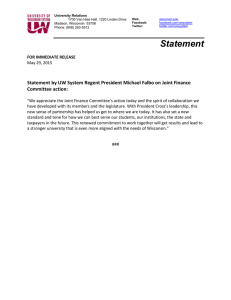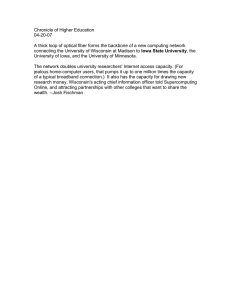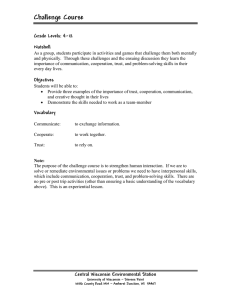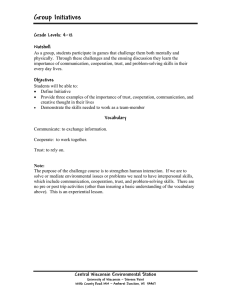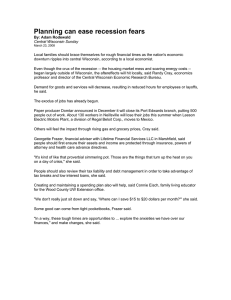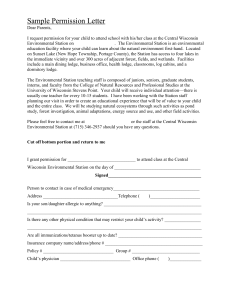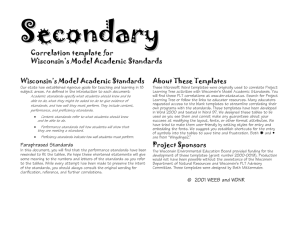S o c i
advertisement
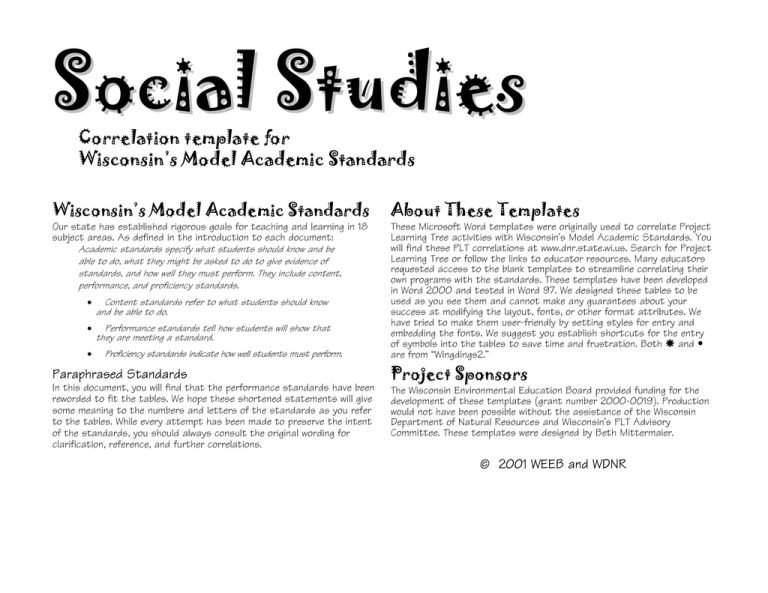
Social Studies Correlation template for Wisconsin’s Model Academic Standards Wisconsin’s Model Academic Standards About These Templates Our state has established rigorous goals for teaching and learning in 18 subject areas. As defined in the introduction to each document: Academic standards specify what students should know and be able to do, what they might be asked to do to give evidence of standards, and how well they must perform. They include content, performance, and proficiency standards. These Microsoft Word templates were originally used to correlate Project Learning Tree activities with Wisconsin’s Model Academic Standards. You will find these PLT correlations at www.dnr.state.wi.us. Search for Project Learning Tree or follow the links to educator resources. Many educators requested access to the blank templates to streamline correlating their own programs with the standards. These templates have been developed in Word 2000 and tested in Word 97. We designed these tables to be used as you see them and cannot make any guarantees about your success at modifying the layout, fonts, or other format attributes. We have tried to make them user-friendly by setting styles for entry and embedding the fonts. We suggest you establish shortcuts for the entry of symbols into the tables to save time and frustration. Both Æ and y are from “Wingdings2.” • Content standards refer to what students should know and be able to do. • Performance standards tell how students will show that they are meeting a standard. • Proficiency standards indicate how well students must perform. Paraphrased Standards In this document, you will find that the performance standards have been reworded to fit the tables. We hope these shortened statements will give some meaning to the numbers and letters of the standards as you refer to the tables. While every attempt has been made to preserve the intent of the standards, you should always consult the original wording for clarification, reference, and further correlations. Project Sponsors The Wisconsin Environmental Education Board provided funding for the development of these templates (grant number 2000-0019). Production would not have been possible without the assistance of the Wisconsin Department of Natural Resources and Wisconsin’s PLT Advisory Committee. These templates were designed by Beth Mittermaier. © 2001 WEEB and WDNR Content Standard Students in Wisconsin will learn about geography through the study of the relationships among people, places, and environments. Æ Activity directly addresses the achievement of the standard. y Activity reinforces or supports the achievement of the standard. Name of your program Grade and Environments A. Geography: People, Places, A.8.11 Give examples of the affects of current global issues A.8.10 Identify major discoveries in science and technology A.8.9 Describe how buildings reflect cultural values A.8.8 Describe how people interact with the physical environment A.8.7 Describe how people and their influences move A.8.6 Describe environmental effects of physical changes A.8.5 Identify and compare natural resource bases of areas A.8.4 Conduct a historical study to analyze use of environment A.8.3 Use an atlas to find information A.8.2 Construct mental maps of selected areas A.8.1 Use a variety of geographic representations A.4.9 Show how knowledge has led to environmental changes A.4.8 Identify major changes in the local community A.4.7 Identify connections between local and global communities A.4.6 Identify and describe environmental changes A.4.5 Use resources to gather information about places A.4.4 Describe ways people interact with the physical environment A.4.3 Construct a map of the world from memory A.4.2 Locate physical features on a map or globe A.4.1 Use reference points to locate positions Social Studies Performance Standards Grade 4 Grade 8 List of activities 2 B. History: Time, Continuity, and Change Content Standard Students in Wisconsin will learn about the history of Wisconsin, the United States, and the world, examining change and continuity over time in order to develop historical perspective, explain historical relationships, and analyze issues that affect the present and future. Æ Activity directly addresses the achievement of the standard. y Activity reinforces or supports the achievement of the standard. Name of your program Grade B.8.12 Describe how history can be organized and analyzed B.8.11 Summarize Wisconsin American Indian tribal issues B.8.10 Analyze relationships among groups of people B.8.9 Explain why science & technology need regulations B.8.8 Identify major scientific discoveries and innovations B.8.7 Identify significant events and people in major eras B.8.6 Analyze important political values B.8.5 Use historical evidence to determine political values B.8.4 Explain how events may be interpreted differently B.8.3 Describe the relationships between significant events B.8.2 Demonstrate how significant events influence history B.8.1 Interpret the past using primary source materials B.4.10 Explain historical and current Wisconsin American Indians B.4.9 Describe examples of cooperation and interdependence B.4.8 Compare past and present technologies B.4.7 Identify important events and famous people B.4.6 Explain the significance of holidays and symbols B.4.5 Identify the meaning of important political values B.4.4 Compare contemporary life with life in the past B.4.3 Examine literature to understand the lives of people B.4.2 Use timelines to describe eras in history B.4.1 Identify and examine sources of historical information Social Studies Performance Standards Grade 4 Grade 8 List of activities 3 C. Political Science and Citizenship Content Standard Students in Wisconsin will learn about political science and acquire the knowledge of political systems necessary for developing individual civic responsibility by studying the history and contemporary uses of power, authority, and governance. Æ Activity directly addresses the achievement of the standard. y Activity reinforces or supports the achievement of the standard. Name of your program Grade C.8.9 Describe the role of international organizations C.8.8 Identify how advocates participate in public policy debate C.8.7 Use relevant information to understand an issue C.8.6 Explain the role of political parties and interest groups C.8.5 Explain how the Constitution sustains balance C.8.4 Describe the separation of power in America C.8.3 Explain laws and the purposes and powers of government C.8.2 Discuss important political documents and decisions C.8.1 Identify and explain democracy’s basic principles C.4.6 Use relevant information to understand an issue C.4.5 Explain how civic actions benefit the community C.4.4 Explain the basic purpose of American government C.4.3 Explain how groups develop rules of behavior C.4.2 Identify our country’s citizen rights documents C.4.1 Identify and explain individual rights and responsibilities Social Studies Performance Standards Grade 4 Grade 8 List of activities 4 Consumption Content Standard Students in Wisconsin will learn about production, distribution, exchange, and consumption so that they can make informed economic decisions. Æ Activity directly addresses the achievement of the standard. y Activity reinforces or supports the achievement of the standard. Name of your program Grade Distribution, Exchange, D. Economics: Production, D.8.11 Describe how personal decisions can have a global impact D.8.10 Identify the economic roles of institutions D.8.9 Explain how earning power of workers is determined D.8.8 Explain how and why entrepreneurs take risks D.8.7 Identify the location and use of natural resources D.8.6 Explain viewpoints concerning economic issues D.8.5 Illustrate the government’s role in the economy D.8.4 Describe how investments affect the standard of living D.8.3 Describe Wisconsin’s role in national and global economies D.8.2 Identify and explain basic economic concepts D.8.1 Explain how money facilitates economic exchanges D.4.7 Describe the effects of personal economic decisions D.4.6 Identify the economic roles of institutions D.4.5 Distinguish between private and public goods and services D.4.4 Explain how business depends upon specialized workers D.4.3 Identify local goods and services with global ties D.4.2 Identify the results of economic decisions D.4.1 Describe and explain personal finances Social Studies Performance Standards Grade 4 Grade 8 List of activities 5 Individuals, Institutions, and Society Content Standard Students in Wisconsin will learn about the behavioral sciences by exploring concepts from the discipline of sociology, the study of the interactions among individuals, groups, and institutions; the discipline of psychology, the study of factors that influence individual identity and learning; and the discipline of anthropology, the study of cultures in various times and settings. Æ Activity directly addresses the achievement of the standard. y Activity reinforces or supports the achievement of the standard. Name of your program Grade E. The Behavioral Sciences: E.4.15 Describe instances of cooperation and interdependence E.4.14 Describe the effects of differences in cultures E.4.13 Investigate the ways cultures meet human needs E.4.12 Give examples of contributions made by citizens E.4.11 Explain how artistic creations express culture E.4.10 Explain how the media may influence opinions & decisions E.4.9 Explain how people learn about others who are different E.4.8 Distinguish among the values and beliefs of groups E.4.7 Explain why individuals respond in different ways E.4.6 Give examples of group and institutional influences E.4.5 Describe institutions & their contributions to community E.4.4 Describe the ways cultures influence people’s daily lives E.4.3 Describe how families are alike and different E.4.2 Explain the influences on individual development E.4.1 Explain the influences on individual learning Social Studies Performance Standards Grade 4 List of activities 6 Individuals, Institutions, and Society Content Standard Students in Wisconsin will learn about the behavioral sciences by exploring concepts from the discipline of sociology, the study of the interactions among individuals, groups, and institutions; the discipline of psychology, the study of factors that influence individual identity and learning; and the discipline of anthropology, the study of cultures in various times and settings. Æ Activity directly addresses the achievement of the standard. y Activity reinforces or supports the achievement of the standard. Name of your program Grade E. The Behavioral Sciences: E.8.14 Describe instances of cooperation and interdependence E.8.13 Compare and contrast the beliefs expressed in art E.8.12 Describe conflict resolution and peer mediation strategies E.8.11 Explain how beliefs and practices may lead to conflict E.8.10 Explain the influence of cultural expression E.8.9 Give examples of cultural contributions E.8.8 Show how the media may influence individuals and groups E.8.7 Explain bias, prejudice, and stereotyping E.8.6 Explain the influences on individual interactions E.8.5 Explain how groups and institutions meet needs E.8.4 Explain how people may contribute to society E.8.3 Describe the ways cultures influence people’s daily lives E.8.2 Illustrate the influences on individual development E.8.1 Illustrate the influences on individual learning Social Studies Performance Standards Grade 8 List of activities 7

